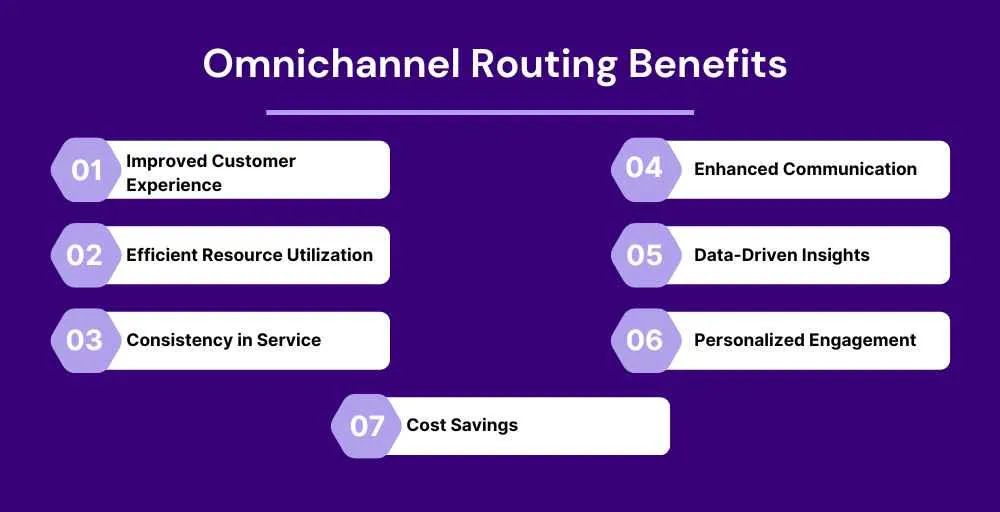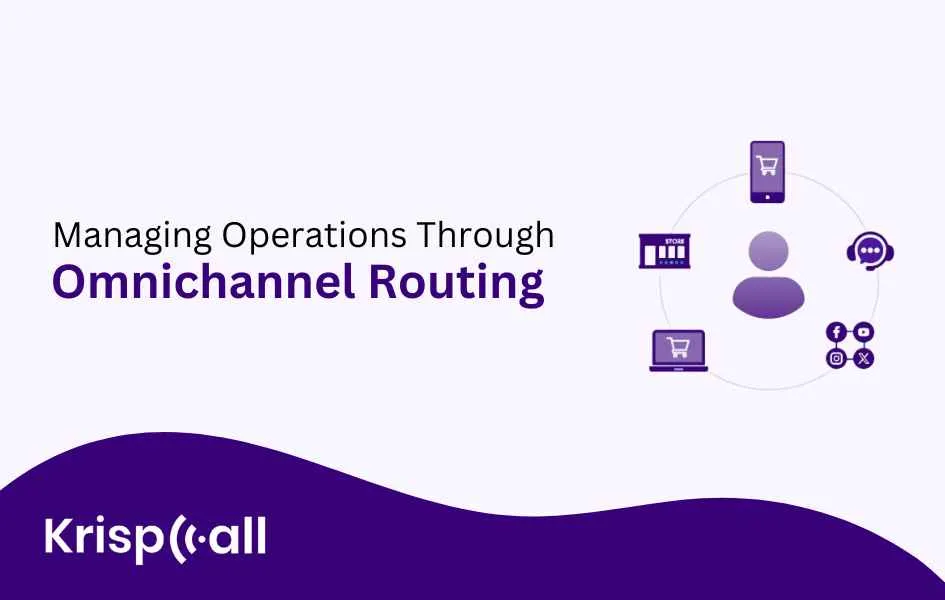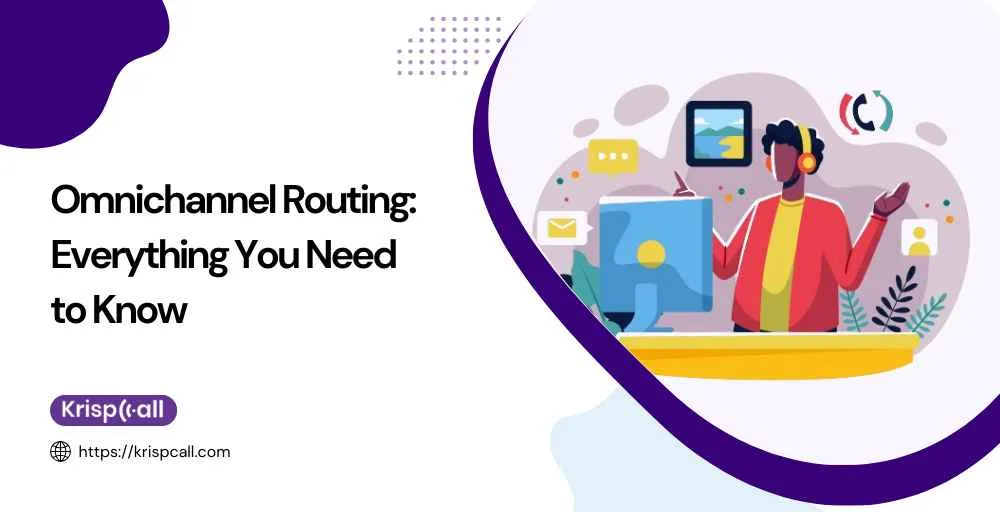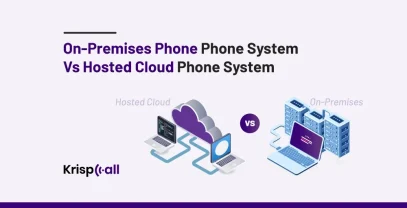Customers expect personalized and consistent experiences across all channels in today’s digital age. Recent data from a BRP report shows that 87% of consumers actively look for customized interactions.😳
Omnichannel routing allows businesses to meet customer expectations by delivering seamless and personalized customer support across various channels. It also guarantees that agents can effectively handle their tasks without being overburdened.
In this guide, you will learn about the omnichannel routing system, how it works, its benefits, and key strategies for effectively managing operations through omnichannel routing.😀
🗝️Key Highlights
- Omnichannel routing seamlessly manages customer communications across multiple channels (such as phone, email, and chat).
- The key benefits of omnichannel routing are improved customer experience, efficient resource utilization, data-driven insights, personalized engagement, and cost savings.
- Agile scalability, real-time monitoring, automated routing, customer self-service, and a feedback loop are effective ways to manage operations through omnichannel routing.
- Intelligent Routing, Real-time Analytics, Seamless Integration, Email, Web messaging/Live chat, Workflow Automation, Chatbots, and Voicebots are the essential features of an effective omnichannel routing system.
Let’s get started.🚀
What Is Omnichannel Routing?
Omnichannel routing is a customer service and communication management strategy that provides a smooth experience across multiple channels, such as inbound and outbound voice calls, text messages (SMS), emails✉️, live chat, and social media.
Omnichannel Cloud Contact Center utilizes omnichannel routing to manage customer interactions across various communication channels efficiently.
Omnichannel Routing also provides customers with a consistent and personalized experience across all channels by routing their inquiries to the most appropriate agent or department regardless of their channel.

Implementing omnichannel routing effectively helps businesses avoid redundant routing and ensures seamless and efficient customer interactions across multiple channels.
Managing various customer requests from different channels can be complex, but top contact centers tackle this challenge with comprehensive all-in-one solutions that include omnichannel routing capabilities.
The omnichannel routing solution boosts customer satisfaction, streamlines communication, and ensures a unified brand experience for businesses. Customers can easily switch between channels seamlessly without encountering disruptions or loss of information.
Scenarios Of Omnichannel Routing Solution
- Customer Inquiry: A customer sends a message via chat about a product. The chatbot handles initial queries but escalates to a live agent when the issue is complex, using omnichannel routing to connect the chat session seamlessly to the agent’s interface.
- Social Media Interaction: A customer posts a question about a service on social media. The contact center’s omnichannel routing system detects the post, prioritizes it based on sentiment analysis, and assigns it to an agent with expertise in social media interactions.
- Email Support: A customer emails requesting assistance with account settings. The email is automatically categorized, routed to the appropriate department, and assigned to an agent specializing in account management queries.
- Phone Call Follow-Up: After a phone call with a customer, an agent notes a follow-up action in the CRM system. The omnichannel routing system schedules a follow-up email to ensure continuity of support and record keeping.
- SMS Notifications: A customer opts-in for SMS notifications. The system uses omnichannel routing to send relevant updates and promotions based on the customer’s preferences and purchase history.
How Does Omnichannel Routing Work?
An omnichannel routing system is used in modern business communication to seamlessly handle customer interactions across multiple channels.
It uses intelligent routing software to ensure seamless engagement, personalized service, and consistent communication experiences for customers across all touchpoints.
When new queries arrive, the call center software utilizes Artificial Intelligence (AI), Automatic Speech Recognition (ASR), and Natural Language Processing (NLP) to understand customer intent.
After understanding the intent, customers are guided through an Automatic Call Distribution (ACD) software to a qualified agent, regardless of their communication channel.
The system also considers factors like queue time to minimize wait times and can prioritize tasks based on preset rules. Additionally, it automatically updates agent availability to optimize productivity and ensure a smooth workflow.
Omnichannel routing configurations involve:
- Channel Integration: Integrates various channels for seamless interaction.
- Customer Context: Utilizes customer data for personalized service.
- Skill-Based Routing: Routes inquiries to suitable agents based on skills.
- Priority Routing: Prioritizes urgent customer requests for prompt resolution.
- Rules-Based Routing: Establishes criteria for efficient handling of needs.
- Automated Routing: Uses automation tools for faster response times.
- Queue Management: Prioritizes and distributes requests efficiently.
- Real-Time Monitoring: Provides insights for continuous optimization.
- Omnichannel Reporting: Generates comprehensive analytics for decision-making.
- Predictive behavioral routing: Analyzes past customer behavior to predict future needs and route inquiries accordingly.
- Round robin/rotary: Distributes incoming requests evenly among available agents in a rotational manner.
What Are The Key Benefits Of Omnichannel Routing?
The key benefits of Omnichannel Routing include empowering agents to engage with customers across digital and voice channels effectively. This solution includes automatic call distribution (ACD), Interactive voice response (IVR), interaction channel support, and a proactive outbound dialer.
The key benefits of omnichannel routing are:

- Improved Customer Experience: Omnichannel routing ensures customers receive consistent service and support across all channels. This leads to a smoother and more satisfying experience, which builds trust and encourages repeat business.
- Efficient Resource Utilization: Omnichannel routing optimizes agent productivity by intelligently routing queries to the most suitable agents based on their skills, availability, and workload. This leads to faster query resolution and better resource utilization.
- Consistency in Service: Customers receive the same level of service and access to information regardless of their chosen communication channel. This consistency eliminates confusion and enhances the overall customer experience.
- Enhanced Communication: Omnichannel routing enables real-time communication. It lets businesses respond promptly to customer inquiries, issues, and feedback. This responsiveness improves customer satisfaction and engagement.
- Data-Driven Insights: The system collects valuable data and analytics on customer interactions, such as communication preferences, common queries, and customer sentiment. These insights help businesses make informed decisions, improve processes, and effectively customize services to meet customer needs.
- Personalized Engagement: Omnichannel routing uses data and customer history to facilitate personalized interactions. Agents can access customer information quickly, address customers by name, and offer relevant solutions. This creates a more personalized and engaging experience.
- Cost Savings: Omnichannel routing helps businesses reduce operational expenses by streamlining workflows, reducing errors, and maximizing agent efficiency. The optimized use of resources and improved customer satisfaction contribute to long-term cost savings and improved ROI.
What Are The Ways To Effectively Manage Operations Through Omnichannel Routing?
Omnichannel routing is a key strategy for modern businesses to deliver seamless customer experiences across multiple communication channels such as phone, email, chat, social media, and more.
Some key ways to effectively manage operations through omnichannel routing are:

1. Agile Scalability
Omnichannel routing is vital for implementing agile scalability in business operations. It automatically distributes work across various channels based on agent capacity and availability.
It enables teams to handle growing volumes of customer interactions more efficiently. This automation reduces manual effort, optimizes resource allocation, and allows teams to scale up or down seamlessly as needed, contributing to agile scalability in managing operations.
2. Centralized Customer Data
It involves establishing a unified system or database where all customer-related information is stored and managed. This system ensures consistency and accuracy in customer interactions across various communication channels, such as phone, email, chat, and social media.
Businesses can provide personalized and consistent customer experiences by aggregating data from these channels into a centralized location. Agents or customer support teams can access comprehensive customer profiles, including past interactions, preferences, purchase history, and contact details. Centralized data management also facilitates data analysis and insights. This helps businesses understand customer behavior, trends, and choices to improve service delivery and make informed decisions.
3. Real-time Monitoring
Real-time monitoring in omnichannel routing involves using analytics tools to track and analyze the performance of various communication channels. Analytics tools track metrics such as response times, resolution rates, customer satisfaction scores, and the number of interactions on each channel. By analyzing this real-time data, businesses can identify trends and patterns in customer behavior, such as preferred channels for specific inquiries or peak times of customer activity.
Knowing when customer inquiries peak allows businesses to allocate resources effectively. For example, they can schedule more agents or adjust workflows during these busy periods to ensure prompt responses and minimize wait times. Additionally, real-time monitoring helps optimize resource allocation by shifting agents to balance workload across channels based on current demand.
4. Automated Routing
Automated routing in omnichannel systems uses intelligent algorithms to direct incoming inquiries to the best-matched agent or department. This process considers factors like the skills of available agents, workload distribution to prevent overload, customer history for personalized service, and real-time adjustments based on agent availability and routing rules.
By automating this routing process, businesses streamline customer service, boost agent productivity, and enhance overall customer satisfaction.
5. Unified Dashboards
A unified dashboard in omnichannel systems aggregates data from all communication channels into a single interface for agents. This comprehensive view enables agents to understand customer interactions across various channels, such as phone calls, emails, chats, and social media, in one place.
Additionally, a unified dashboard provides real-time updates, alerts, and performance metrics. It empowers agents to make informed decisions and respond promptly to customer inquiries. This centralized approach improves efficiency, reduces response times, and enhances the overall quality of customer service.
6. Customer Self-service
Implementing customer self-service options such as FAQs, chatbots, and knowledge bases is crucial for effectively managing operations through omnichannel routing. These tools empower customers to find answers independently, reducing the workload on live agents.
By offering 24/7 availability and consistent information across all channels, businesses can scale effortlessly, enhance the customer experience, and optimize resource utilization. This cost-effective approach improves response times and ensures a cohesive brand image.
7. Feedback Loop
Establishing a feedback loop in omnichannel routing is vital for gathering customer insights about their experiences. This feedback helps businesses improve continuously, address pain points, and enhance customer satisfaction.
By analyzing customer feedback across channels, companies can identify trends, optimize processes, and tailor their services to meet customer expectations effectively. This proactive approach improves the customer experience, fosters loyalty, and strengthens brand reputation.
Wrapping Up
In conclusion, omnichannel routing is an essential strategy for businesses to meet the increasing demand for personalized and consistent customer experiences across multiple channels. It allows businesses to efficiently manage customer interactions, improve communication, and enhance overall customer satisfaction. 💫
By effectively using omnichannel routing, businesses can streamline operations, optimize resource utilization, and foster long-term customer loyalty. It also empowers businesses to deliver exceptional customer support and drive sustainable growth in today’s digital age.🌟
FAQs
What Are The Differences Between Omnichannel Routing And Multichannel Routing?
Omnichannel routing focuses on providing a seamless and integrated experience across all communication channels. It ensures continuity and consistency in customer interactions. It aims to unify data and workflows, allowing customers to switch between channels effortlessly while maintaining context.
On the other hand, multichannel routing involves managing interactions across multiple channels but may lack integration and synchronization between channels. Customers may experience disjointed interactions as each channel operates independently, without a centralized view of their journey.
Is Omnichannel Routing Cost-effective For Businesses?
Yes, Omnichannel routing can be cost-effective for businesses in the long run. Implementing a robust omnichannel system may require initial investments in technology and training.
What Are The Key Features Of An Effective Omnichannel Routing System?
The key features of an effective omnichannel routing system are:
- Intelligent Routing
- Real-time Analytics
- Seamless Integration
- Web messaging/ Live chat
- Workflow Automation
- Proactive Engagement
- Chatbots and Voicebots
- Knowledge base creation tools





